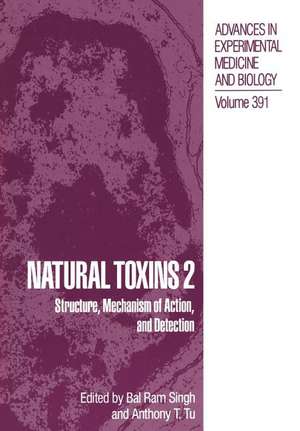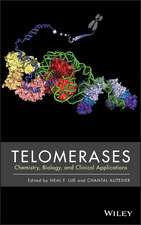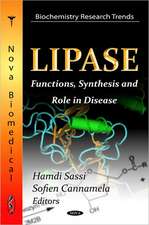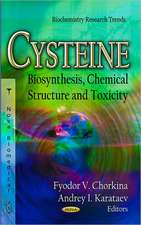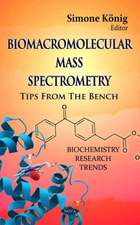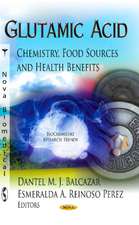Natural Toxins 2: Structure, Mechanism of Action, and Detection: Advances in Experimental Medicine and Biology, cartea 391
Editat de Bal Ram Singh, Anthony T. Tuen Limba Engleză Paperback – 26 sep 2011
Din seria Advances in Experimental Medicine and Biology
- 9%
 Preț: 719.56 lei
Preț: 719.56 lei - 5%
 Preț: 1113.83 lei
Preț: 1113.83 lei - 20%
 Preț: 691.93 lei
Preț: 691.93 lei - 5%
 Preț: 717.00 lei
Preț: 717.00 lei - 5%
 Preț: 717.00 lei
Preț: 717.00 lei - 5%
 Preț: 715.35 lei
Preț: 715.35 lei - 5%
 Preț: 716.28 lei
Preț: 716.28 lei - 5%
 Preț: 239.86 lei
Preț: 239.86 lei -
 Preț: 642.95 lei
Preț: 642.95 lei - 5%
 Preț: 820.42 lei
Preț: 820.42 lei - 5%
 Preț: 715.71 lei
Preț: 715.71 lei - 15%
 Preț: 640.24 lei
Preț: 640.24 lei - 15%
 Preț: 641.38 lei
Preț: 641.38 lei - 5%
 Preț: 1031.00 lei
Preț: 1031.00 lei - 5%
 Preț: 716.28 lei
Preț: 716.28 lei - 5%
 Preț: 717.20 lei
Preț: 717.20 lei - 20%
 Preț: 1161.71 lei
Preț: 1161.71 lei - 5%
 Preț: 1170.51 lei
Preț: 1170.51 lei - 18%
 Preț: 1119.87 lei
Preț: 1119.87 lei - 5%
 Preț: 1288.48 lei
Preț: 1288.48 lei - 5%
 Preț: 1164.67 lei
Preț: 1164.67 lei - 5%
 Preț: 1101.73 lei
Preț: 1101.73 lei - 18%
 Preț: 1123.67 lei
Preț: 1123.67 lei - 5%
 Preț: 1435.64 lei
Preț: 1435.64 lei - 20%
 Preț: 1044.10 lei
Preț: 1044.10 lei - 18%
 Preț: 946.39 lei
Preț: 946.39 lei - 5%
 Preț: 292.57 lei
Preț: 292.57 lei - 18%
 Preț: 957.62 lei
Preț: 957.62 lei - 18%
 Preț: 1235.76 lei
Preț: 1235.76 lei - 5%
 Preț: 1231.55 lei
Preț: 1231.55 lei - 5%
 Preț: 1292.30 lei
Preț: 1292.30 lei - 5%
 Preț: 1102.10 lei
Preț: 1102.10 lei - 18%
 Preț: 1132.81 lei
Preț: 1132.81 lei - 5%
 Preț: 1165.19 lei
Preț: 1165.19 lei - 5%
 Preț: 1418.48 lei
Preț: 1418.48 lei - 5%
 Preț: 1305.63 lei
Preț: 1305.63 lei - 18%
 Preț: 1417.72 lei
Preț: 1417.72 lei - 18%
 Preț: 1412.99 lei
Preț: 1412.99 lei - 24%
 Preț: 806.15 lei
Preț: 806.15 lei - 18%
 Preț: 1243.29 lei
Preț: 1243.29 lei - 5%
 Preț: 1429.44 lei
Preț: 1429.44 lei - 5%
 Preț: 1618.70 lei
Preț: 1618.70 lei - 5%
 Preț: 1305.12 lei
Preț: 1305.12 lei - 18%
 Preț: 1124.92 lei
Preț: 1124.92 lei - 5%
 Preț: 1097.54 lei
Preț: 1097.54 lei - 15%
 Preț: 649.87 lei
Preț: 649.87 lei - 5%
 Preț: 1097.54 lei
Preț: 1097.54 lei - 18%
 Preț: 945.79 lei
Preț: 945.79 lei
Preț: 656.58 lei
Preț vechi: 772.44 lei
-15% Nou
Puncte Express: 985
Preț estimativ în valută:
125.66€ • 130.84$ • 106.19£
125.66€ • 130.84$ • 106.19£
Carte tipărită la comandă
Livrare economică 10-24 martie
Preluare comenzi: 021 569.72.76
Specificații
ISBN-13: 9781461380160
ISBN-10: 1461380162
Pagini: 552
Ilustrații: 548 p.
Dimensiuni: 170 x 244 x 29 mm
Greutate: 0.87 kg
Ediția:Softcover reprint of the original 1st ed. 1996
Editura: Springer Us
Colecția Springer
Seria Advances in Experimental Medicine and Biology
Locul publicării:New York, NY, United States
ISBN-10: 1461380162
Pagini: 552
Ilustrații: 548 p.
Dimensiuni: 170 x 244 x 29 mm
Greutate: 0.87 kg
Ediția:Softcover reprint of the original 1st ed. 1996
Editura: Springer Us
Colecția Springer
Seria Advances in Experimental Medicine and Biology
Locul publicării:New York, NY, United States
Public țintă
ResearchCuprins
Overview of Toxins.- 1. Marine Natural Products: Diversity in Molecular Structure and Bioactivity.- 2. Plant Toxins: The Essences of Diversity and a Challenge to Research.- 3. Overview of Snake Venom Chemistry.- 4. Critical Aspects of Bacterial Protein Toxins.- Origin, Structure and Function.- 5. Structure and Function of Cobra Neurotoxin.- 6. Structure and Function of Cobra Venom Factor, the Complement-Activating Protein in Cobra Venom.- 7. A Case Study of Cardiotoxin III from the Taiwan Cobra (Naja naja atra): Solution Structure and Other Physical Properties.- 8. The Staphylococcal and Streptococcal Pyrogenic Toxin Family.- 9. Primary Structural Motifs of Conus Peptides.- 10. Hymenoptera Venom Proteins.- 11. Structure and Functions of Coagulation Factor IX/Factor X-Binding Protein Isolated from the Venom of Trimeresurus flavoviridis.- 12. Structure and Function Relationship of Crotoxin, a Heterodimeric Neurotoxic Phospholipase A2 from the Venom of a South American Rattlesnake.- 13. Atroxase—A Fibrinolytic Enzyme Isolated from the Venom of Western Diamondback Rattlesnake: Isolation, Characterization and Cloning.- 14. Isolation of a Novel Lectin from the Globiferous Pedicellariae of the Sea Urchin Toxopneustes pileolus.- 15. Indian Catfish (Plotosus canius, Hamilton) Venom: Occurrence of Lethal Protein Toxin (Toxin-PC).- 16. Neurotoxin from Black Widow Spider Venom: Structure and Function.- 17. Structural and Functional Studies of Latrodectin from the Venom of Black Widow Spider (Latrodectus tredecimguttatus).- 18. Effects of Toxic Shock Syndrome Toxin-1 and a Site-Directed Mutant, H135A, in Mice.- 19. The Relationship between Histidine Residues and Various Biological Activities of Clostridium perfringens Alpha Toxin.- Mechanism of Action.- 20. Mechanism of Action ofClostridium perfringens Enterotoxin.- 21. Binding Proteins on Synaptic Membranes for Certain Phospholipases A2 with Presynaptic Toxicity.- 22. Pyrularia Thionin: Physical Properties, Binding to Phospholipid Bilayers and Cellular Responses.- 23. The Chemistry and Biological Activities of the Natural Products AAL-Toxin and the Fumonisins.- 24. New Aspects of Amanitin and Phalloidin Poisoning.- 25. Actions of Banana Tree Extract on Smooth and Cardiac Muscles and in the Anesthetized Rat.- 26. The Early Expression of Myotoxicity and Localization of the Binding Sites of Notexin in the Soleus Muscle of the Rat: Notexin and Muscle.- 27. Fumonisin B1 Immunological Effects: The Influence of FB1 to the Early Stage of Immune Response.- 28. Biochemical Studies on the Effect of Plotosus lineatus Crude Venom (in Vivo) and Its Effect on EAC-Cells (in Vitro).- 29. Interaction of Lipopolysaccharide with the Antimicrobial Peptide “Cecropin A”.- 30. Study on the Action Mechanism of Hemorrhagin I from Agkistrodon acutus Venom.- Scientific and Medical Tools.- 31. K252a and Staurosporine Microbial Alkaloid Toxins as Prototype of Neurotropic Drugs.- 32. Structure and Experimental Uses of Arthropod Venom Proteins.- 33. Metamorphoses of a Conotoxin.- 34. Purification and Characterization of Nerve Growth Factors (NGFs) from the Snake Venoms.- 35. Snake Venoms as Probes to Study the Kinetics of Formation and Architecture of Fibrin Network Structure.- 36. Fibrolase, an Active Thrombolytic Enzyme in Arterial and Venous Thrombosis Model Systems.- Detection, Diagnostics and Therapy.- 37. Mass Spectrometric Investigations on Proteinaceous Toxins and Antibodies.- 38. Detection of the Staphylococcal Toxins.- 39. Detection and Identification of Clostridium botulinum Neurotoxins.- 40. Detection ofBotulinum Neurotoxins Using Optical Fiber-Based Biosensor.- 41. Comparative Studies of Antisera against Different Toxins.- 42. New Approaches in Antivenom Therapy.- 43. Distribution of Domoic Acid in Seaweeds Occurring in Kagoshima, Southern Japan.
